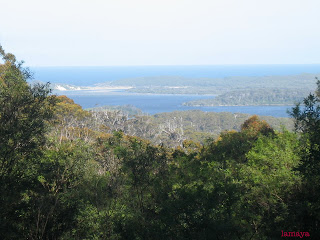With the map on my lap we were ready for our first WA Road Trip--The Pinnacles or Bust! I didn't imagine too many dramas. After all, once we cleared Perth it would be a straight shot up Highway 1. What I didn't expect was how long the trip would take. How could less than a couple of inches on paper take almost 3 hours to drive? We were cruising along at close to 100 km an hour. Well, maybe we were going a little slower since the dead kangaroos every kilometer or so had us a bit freaked out but, still, how on earth did it take us so long to go such a short distance? Hmmmm, perhaps it is the fact that the map on my lap represented one state, but that state just happens to occupy about 1/3 the of the whole continent. We aren't talking California, but rather an area of more than 2,500,000 square kilometers. So much for an early arrival.
After a quick check-in at the Cervantes Caravan Park we headed out to Nambung National Park, home of one of Australia's most unique landscapes.
When we arrived at the Park's entrance we had a good chat with the ranger. He was a bit concerned that we would not be able to fully appreciate the limestone spires that eerily rise out of the sand. First of all, it was fairly warm out and there were lots of flies. Of course, these two things could be overcome with lots of water and a fly net, but there wasn't much to be done about the large number of visitors in the park. Because there was a full moon that evening, there were large crowds. The Ranger suggested that rather than trying to spend too much time in the park that afternoon we visit the interpretive center and take a short walk about, then return at dawn. He assured us that we would have the park to ourselves furthermore, we would get to watch the sun rise and moon set.
Even thought the crowds and flies were aplenty they didn't distract from the huge limestone pillars which vary in size and shape. These formations, which are believed to be over 6,000 years old, are the result of ancient sea shells that were broken down into sand and brought to shore by waves. The lime-rich sand was then carried inland by wind to form large sand dunes. Over time, acidic rain and extreme heat bound the grains of sand together forming Tamala Limestone--which was eventually eroded to form the Pinnacles.
As much as we enjoyed our afternoon walk across a landscape that resembled the set of a science fiction movie, we were glad we took the Park Ranger's advise. As he promised, the next morning our only company was one other car and a dozen or so roo's. The simultaneous sunrise/moonset was spectacular. However, the highlight of the early morning visit had to be the play of the light and shadows. It was no longer as though we were visiting a movie set, but rather as if were transported to a ethereal distant planet--a memory that will not soon be forgotten.

































